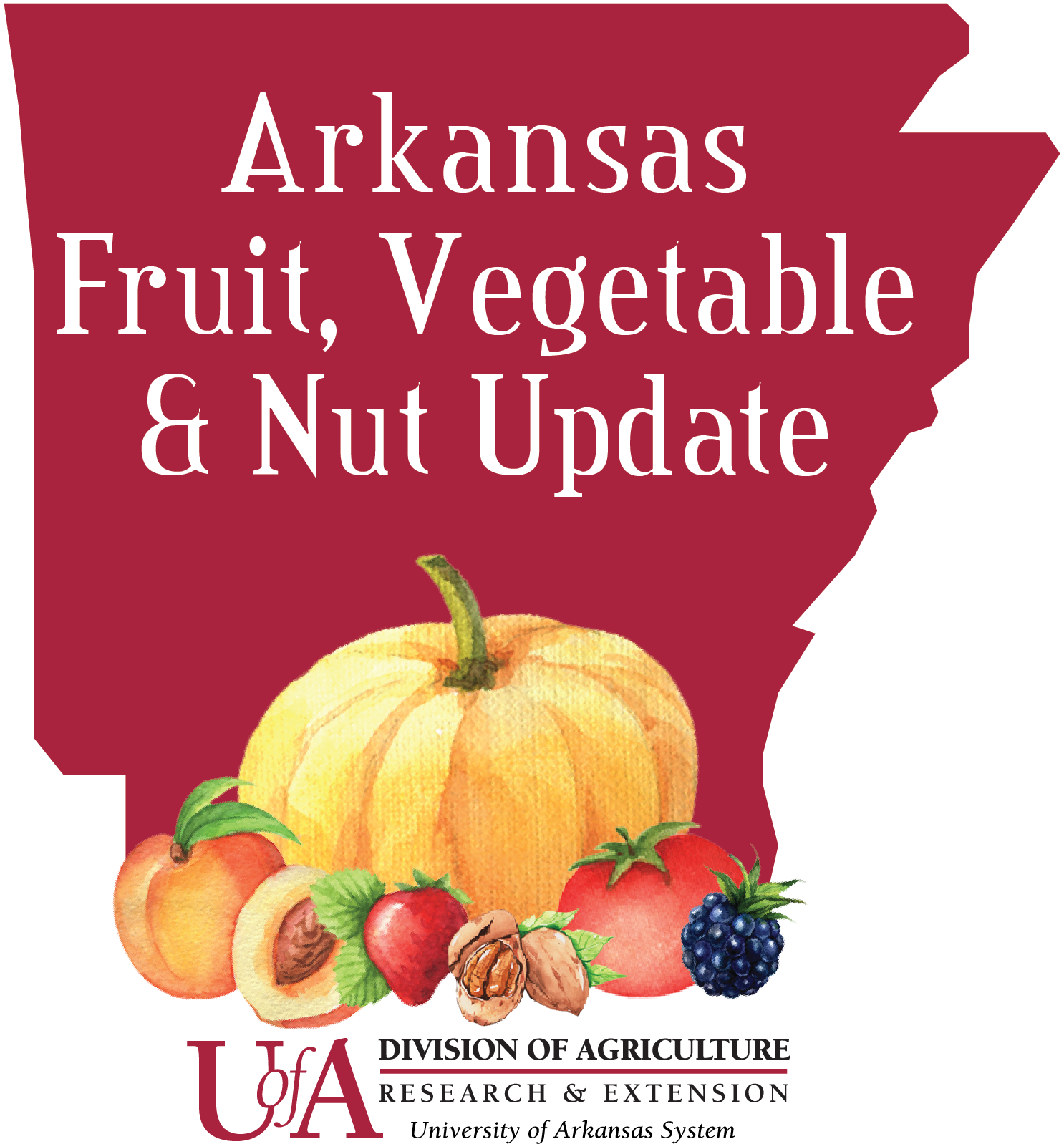
Southern High Bush and Rabbiteye Blueberry Variety Trial Results
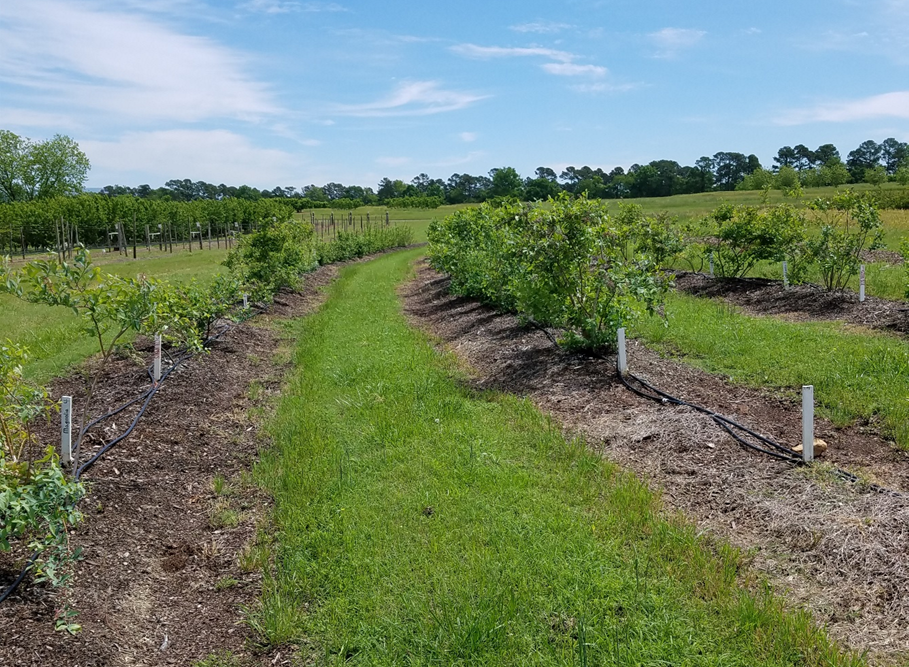
The blueberry variety trial at the Fruit Research Station, Clarksville AR, in the
summer of 2017.
Photo: Amanda McWhirt
A four-year blueberry variety trial was conducted in Clarksville, Arkansas at the
University of Arkansas Fruit Research Station, yield data was collected between 2014
and 2017.
Crop Management
- The project evaluated nine blueberry cultivars, 5 Southern High Bush types and 4 Rabbiteye
types.
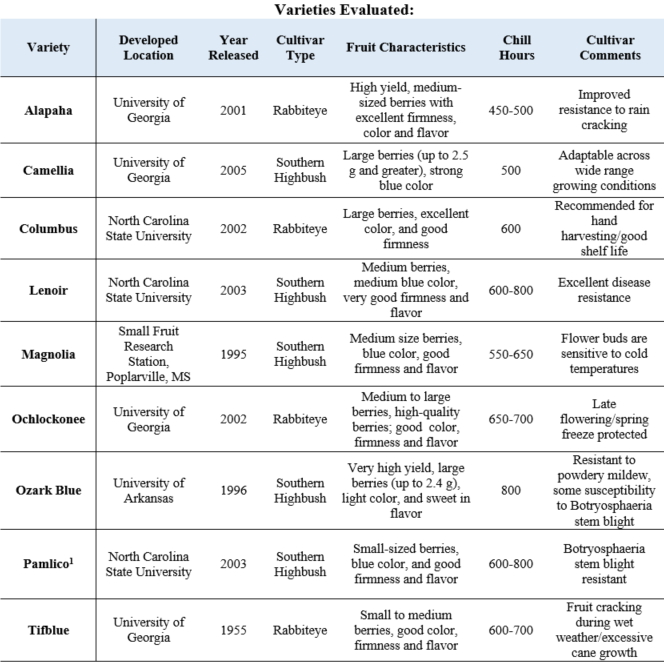 Source: http://www.smallfruits.org/assets/documents/crops/blueberries/06bbcvproc_Nov0206.pdf
Source: http://www.smallfruits.org/assets/documents/crops/blueberries/06bbcvproc_Nov0206.pdf
http://www2.ca.uky.edu/agcomm/pubs/id/id210/id210.pdf
- 1 year old plants were established into pinebark mulch beds in the spring of 2010
- Plants were established with 5’ between plants and a row spacing of 12’
- A standard fertilizer, mulching and pest management program was implemented in 2013.
Prior to program implementation plant establishment was poor and many plants were
lost due to disease. This lack of early crop management likely impacted our results.
- Fungicides (Lime sulfur, Ridomil Gold, Abound and others) were used to control Phomophsis canker and Twig blight. Applications were made beginning at delayed dormant through pre-harvest. No fungicide applications were made during harvest. A single post-harvest application was applied in 2016 and 2017.
- Spotted Wing Drosophila was scouted for and was treated weekly during berry production
- Pre-emergent and burn down herbicides for weed prevention were used on occasion, but the majority of the weed control was done by mulch, hand, and hoe.
- Nitrogen was applied three times per year at bud break, six weeks after bud break,
and then 12 weeks after bud break.
- Nitrogen was applied at a rate of 0.12 lbs of nitrogen per plant per application.
- Foliar applications of micronutrients were applied in the spring of 2015-2017. This was in response to visible iron deficiency symptoms observed in the cultivar Columbus (Fig. 1)
- Mulch was applied every other year with a minimum application of six inches
- Netting was installed in the spring of 2016 and 2017 to limit losses due to birds.
- Pruning was done one time a year during the dormant season (November/December)
Results
The four year averages for first budbreak, first and last harvest dates and yield per acre or hectare (ha) for each cultivar are reported in Table 1. The average harvested yield, berry weight, and soluble solids for individual years are shown in Table 2.
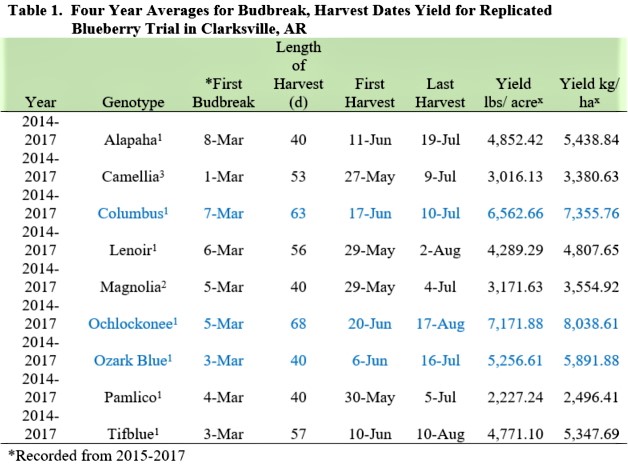
XYield per acre was determined based on a planting of 5 feet between plants and 12
feet
between rows (871 plants per acre)
yThe number of reps varied for each cultivar due to plant death
1Cultivar had 4 reps
2Cultivar had 3 reps
3Cultivar had 2 reps
The average bud break data and first and last harvest dates is only useful for comparing when different varieties break bud and ripen relative to each other. In any given year average bud break for the evaluated varieties ranged from mid-February to late March. First and last harvest dates for each cultivar also varied by 10-14 days between each year of the four years of the study.
In the charts below letters within the same column indicate statistical differences at p<0.05.
The majority of the cultivars performed well. The cultivars; Columbus, Ochlockonee, and Ozark Blue had the highest yields on average, with yields per acre averaging from 5,200-7,200 lbs. per acre (Table 1). By contrast Pamlico, did not stand out with only an average harvest fruit yield of 2,200 lbs. per acre. When year to year harvest data per plot (g) are evaluated, Columbus, Ochlockonee, and Ozark Blue genotypes again showed to have the best performance on a year by year basis with the addition of Camellia (Table 2).
For berry size Camellia, and Ozark Blue both consistently had the largest berry size. Alapaha and Pamlico were varieties that had smaller berries (Table 2).
The fruit flavor characteristics Lenoir and Ochlockonee ranked high for soluble solids
(Brix) a measure of fruit sweetness (Table 2). Ozark Blue tended to have lower ratings
for sweetness.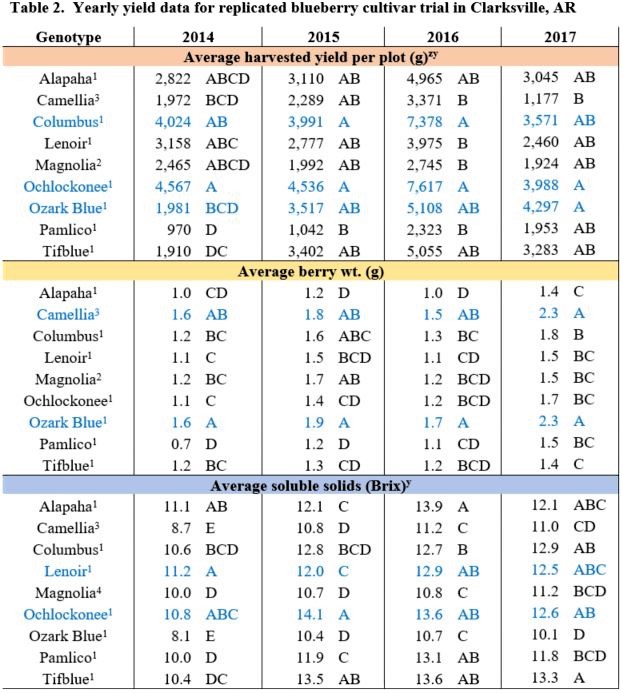
z In the charts below letters within the same column indicate statistical differences
at p<0.05
y The number of reps varied for each cultivar due to plant death
1Cultivar had 4 reps
2Cultivar had 3 reps
3Cultivar had 2 reps
4Cultivar had 1 rep
Rabbiteye Types
Our results indicate that Ochlockonee (pronounced o-clot-nee) performed well for both yields, fruit flavor and size (Fig. 2). It is a late season producer and harvests continued well into August at our site in Clarksville. This cultivar was a favorite of the picking and research crew. Both for fresh eating flavor and ease of harvesting. The plants always looked healthy and exhibited good and consistent growth (or vigor) from year to year. It demonstrated very pretty berry coloring, and even ripening. This is a stand out variety and yielded nearly 2/3 more on the four year average than what the more standard Tiftblue yielded.
Columbus also yielded nicely in a more compact and slightly earlier season than Ochockonee.
Columbus tended to be juicer then the other cultivars. Columbus did struggle with
iron and/or nitrogen deficiencies, and had slightly lower vigor than Ochlockonee.
This was also a variety that stood out and also consistently yielded more on average
than Tiftblue.
Southern High Bush Types
Ozark Blue was a high yielder, with good berry size but was not ranked highly for sweetness as measured by Brix. It has a more compact average 40 day harvest season. Though not as sweet as other cultivars the flavor of Ozark Blue was still good. A couple members of the research crew preferred this berry to its sweeter counterparts stating “it has more flavor.” The berry size made it easy to harvest and stand out from other cultivars. There were issues getting this cultivar to establish and thrive after transplanting. This resulted in the loss of several plants, likely due to poor crop management in the early years of this trial. Once established, however, the plants did well, demonstrating good vigor and, as mentioned earlier, high yields. Ozark Blue is an older release from 1996 but appears to be standing up well to some of the newer releases evaluated in this trial.
Camellia had large berry size and was very early, which may make it suitable for pick-your-own production or for early market sales. This variety however did not stand out to the research team for flavor.
Lenoir is slightly later than Camellia but still very early, had smaller berries but ranked high for fruit sweetness. It was a favorite of the picking and research crew for flavor. They observed that berry size and flavor was ideal for baking into blueberry pancakes, muffins, breads and ice cream. However, it was observed that Lenoir plants seemed to struggle with vigor and often did not send up any new shoots.
Magnolia also stood out to the research crew for flavor but did not compare to Ozark Blue for plant vigor or yields.

Figure 1. Columbus Variety Blueberry Plant in 2017, with Iron Chlorosis symptoms.
Photo: A. McWhirt

Figure 2. Winner of the biggest blueberry in 2017 at 4.59g, an Ochlockonee variety
berry.
Photo: Taunya Ernst
A special thank you is owed to Taunya Ernst and the Research Team at the Fruit Research Station for the care, management and data collection of this project!